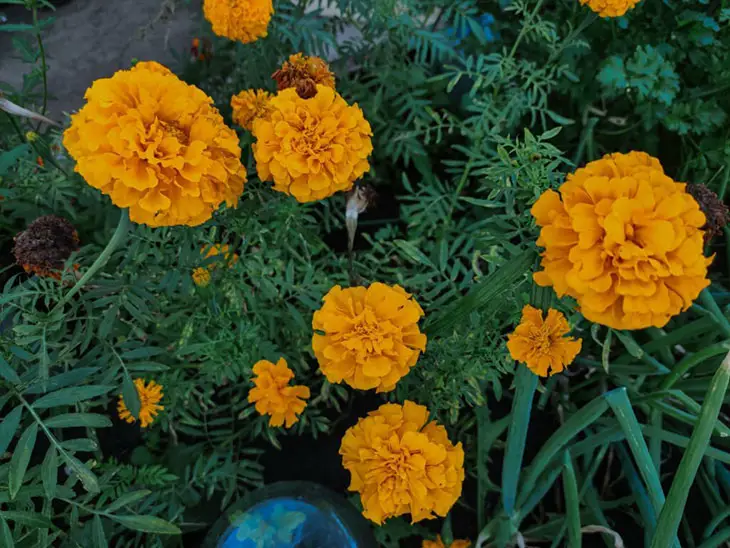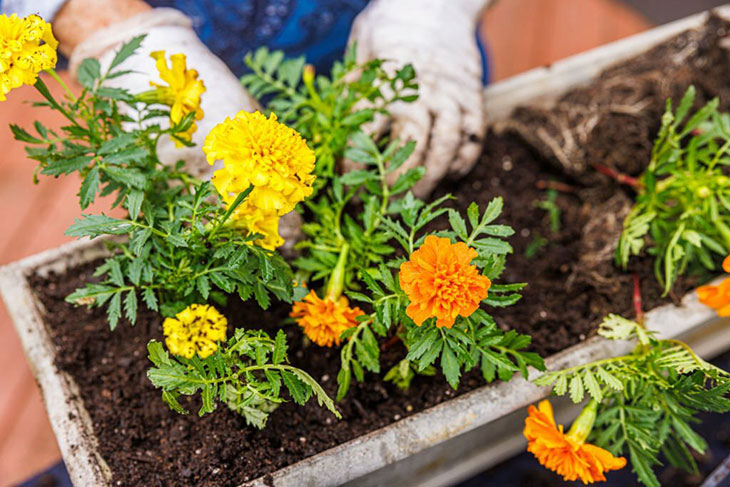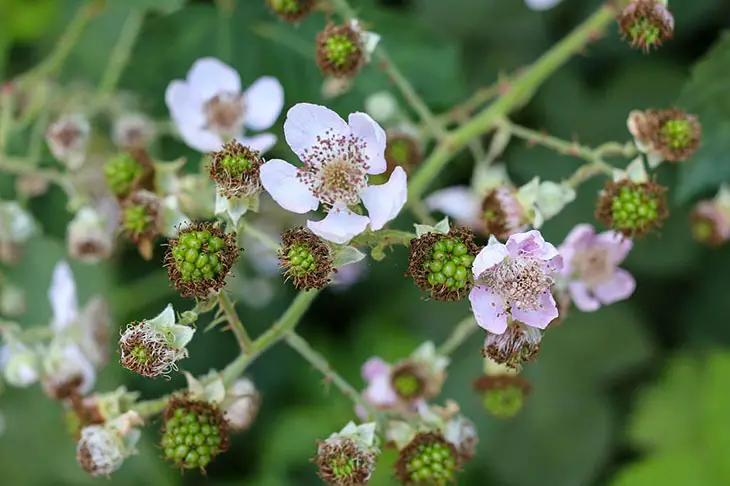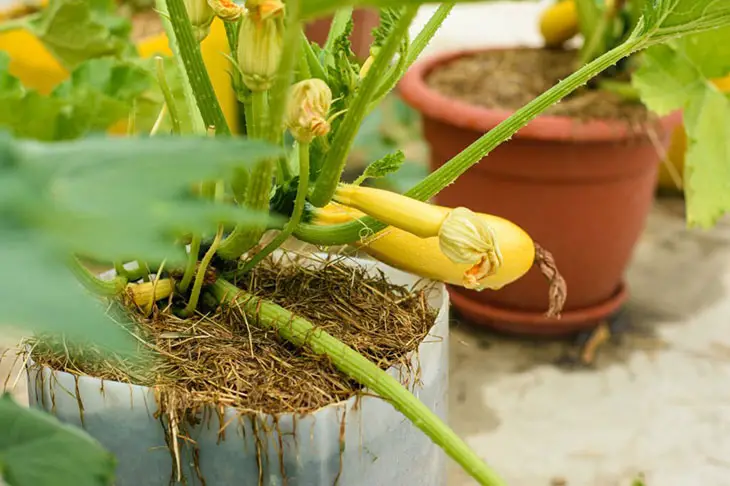
Marigolds, with their vibrant hues and cheerful disposition, are a beloved addition to gardens and landscapes.
Like any other plants, the success of these sunny blooms often depends greatly on sunlight.
Will marigolds grow in shade? Let’s read on to explore the growing process of marigolds, factors that can influence their light requirements, and learning how to plant them is a great experience.
Will Marigolds Grow In Shade?

No. Marigolds thrive in full sunlight. While they can survive in light shade briefly, consistent shade inhibits their growth and flowering potential.
How much sun does a marigold need? It requires at least 6 hours of direct sun exposure daily to flourish, more than Begonias needs.
These sun-loving annuals, encompassing various varieties such as French, Hybrid, and African, all need abundant sunlight.
How Much Shade Can Marigolds Withstand?
Marigolds can only endure around 20% shade briefly. Even then, they will not thrive unless provided with bright, direct light for at least 6 hours.
When lacking adequate sunlight, marigolds can suffer from the following problems:
- Stunted growth
- Thinner foliage
- Reduced blooming
In addition, shade can make them susceptible to powdery mildew, a detrimental fungal condition.
Why Do Marigolds Need Full Sun?
Photosynthesize
Marigolds require full sun to engage in photosynthesis throughout the day.
This vital process enables the plants to continuously grow multiple flowers, including dense double flower heads in certain varieties.
Photosynthesis converts light energy into chemical energy stored in the form of glucose. This energy is essential for the plant’s growth, development, and the production of flowers.
Therefore, a lack of sunlight will lead to weaker growth and fewer flowers.
Beyond promoting flowering and foliage growth, full sun exposure enhances the fragrance of marigolds.
The scent of these flowers, like lavender and other fragrant blooms, relies on the sunlight they receive.
Fragrant floral scents comprise volatile organic compounds (VOCs) and essential oils. They are released into the atmosphere to attract pollinators.
Sunlight facilitates the evaporation of these essential oils from the petals, intensifying the floral fragrance.
Prevent Pests, Diseases, and Wilting
Full sun can prevent a range of common issues, including wilting and pest infestations.
Marigolds are susceptible to several diseases, notably leaf spots, blight, root rot, wilt, and aster yellows. Many of these diseases are fungal and thrive in moist, humid conditions.
Full sun exposure helps to keep the soil and foliage dry, reducing the risk of these diseases.
Besides, sunlight also helps the soil dry out faster after watering. This is essential for warding off fungal wilt pathogens like Verticillium and Fusarium oxysporum.
Marigolds are also prone to pest infestations, with common culprits like root weevils, leafhoppers, and plant bugs. Full sun can deter some pests as they prefer shadier and more sheltered areas.
Moreover, healthy marigold plants are more resilient against pest damage.
Control Soil Moisture
Full sunlight is critical for marigolds for their growth and maintaining soil moisture at optimal levels.
Most marigolds thrive in well-draining, slightly acidic soil. They struggle in water-logged or overly saturated soil. In such conditions, standing water in the soil can wreak havoc on the plants.
Moreover, excessively humid and wet conditions can exacerbate infections and other pathogens.
Full sun exposure aids in maintaining drier soil, minimizing the persistence of moisture that contributes to these problems.
How To Plant Marigolds?

Choosing The Right Place And Sowing Seeds
Do marigolds like shade? No, when choosing a planting spot for marigolds in your garden, ensure it receives adequate sunlight throughout the day.
Marigolds prefer fertile soil that is loose and well-draining, although they can tolerate drier conditions.
If you’re starting from seeds, sow them directly in the garden with about a 1-inch spacing. Otherwise, once the root system is established, you can begin sowing in seed trays for later transplanting.
Depending on the marigold variety, space them 8 inches apart for shorter types and 10-12 inches apart for larger African varieties. Ensure enough room for the plants to grow and for proper air circulation.
Watering
It’s best to let the soil dry out slightly between watering sessions, but they can be sensitive if their leaves get wet.
Water the base of the plants, keeping the soil consistently moist without becoming overly wet. During hot summer months, provide adequate moisture to protect the plants from drought stress.
Fertilizing
Marigolds flourish when planted in nutrient-rich soil. Begin by incorporating organic compost into the soil to enhance its fertility.
Once you notice signs of nutrient deficiency during the growing season, it’s time to apply a light layer of fertilizer with an NPK ratio of 5-10-5.
However, avoid excessive fertilization, as it can lead to lush foliage at the expense of flower production.
Fertilize marigolds at the beginning of the growing season and again mid-season if needed. Applying fertilizer too late in the season may stimulate excessive growth without sufficient time for flowering.
Trimming, Pruning, And Mulching
Consider occasional pruning and deadheading to keep your marigold plants healthy and vibrant. The deadheading process is similar to when you do with butterfly bushes.
Besides, removing spent blossoms if necessary. You can also prune back tall stems that can encourage new growth and enhance the overall appearance of your marigolds.
In addition, mulch around your marigolds with organic materials such as straw or wood chips. This can offer weed suppression, moisture retention, and temperature regulation benefits.
Ensure a 2-to-3-inch layer of mulch, avoiding direct contact with plant stems. It’s best to replenish it as needed to maintain its effectiveness in supporting your marigolds’ growth.
Controlling Pest And Disease
Marigolds are pest-resistant and often used as natural repellents for other garden plants. However, they can still face issues such as earwigs, aphids, spider mites, slugs, cabbage moths, and thrips.
To address these pests, you can use natural methods such as water sprays, traps, or introducing beneficial insects.
Besides, watch out for diseases like aster yellows, powdery mildew, collar rot, wilt, and root rot. Ensure there’s good airflow around your plants by giving them enough space when planting.
If you notice any infected plants, remove them promptly to prevent the issue from spreading.
You can also use organic solutions like neem oil or insecticidal soap to manage pests and diseases without using harsh chemicals.
These methods will help ensure that your marigolds thrive naturally and are free from problems. After all, you can enjoy their beautiful blooms all season long.
Consider Planting Marigolds As Companion Plants
Though lacking science-backed proof, many gardeners, including me, have noticed that marigolds are great companion plants in our garden.
They naturally protect them and neighboring crops from pets such as boxelder bugs or aphids.
I usually used vinegar to shoo away boxelder bugs, but it didn’t work until I planted marigolds around my raised garden bed.
Marigolds effectively repel nematodes, harmful soil-dwelling worms that can harm plant roots. Thus, they’re excellent companions for nematode-sensitive plants like tomatoes.
They also deter aphids, common garden pests that can damage various plants. You should choose compact types like French or signet marigolds to avoid overshadowing other plants.
Interplant marigolds between rows or flower beds provide proper spacing to prevent overcrowding. Besides, ensure your garden thrives naturally with reduced pest pressures.
To discourage whitefly infestations, you can place marigolds around cucumbers and tomatoes, especially in greenhouse settings.
What Are The Factors That Can Influence Light Levels?

Region
The geographic location of your garden significantly impacts the intensity and path of sunlight.
SunCalc maps and similar tools can help you assess the sunlight patterns in your specific region at different times of the day. It assists you in choosing the optimal placement for your marigolds.
Proper positioning becomes even more critical in regions with lower light intensity or areas prone to cloudy and rainy summer weather.
Providing them with 6 to 8 hours of sunlight daily in such regions is recommended to ensure your marigolds thrive.
Season
Seasonal variations can affect both the intensity and direction of sunlight. The choice of the planting location remains consistent.
However, seasonal changes can impact the timing of growth and blooming.
Marigolds may bloom slightly later in spring or early summer in cooler regions. Meanwhile, warmer areas may experience earlier flowering.
As the season comes to an end, consider pruning your marigolds in preparation for the following spring.
Species Of Marigold
Various marigold species differ in their tolerance to heat and sunlight. African Marigolds thrive in hot conditions and intense sunlight. Thus, it is suitable for warm climates and full sun exposure.
Can marigolds grow in partial shade? French Marigolds are less heat-tolerant and may benefit from partial shade in scorching summers.
Besides, Signet Marigolds, with their delicate petals, can barely struggle in intense heat. Therefore, they are suited for cooler regions or areas during the hottest parts of the day.
Choose the marigold variety that matches your local climate to ensure successful growth. Also, it’s best to water them frequently to mitigate heat stress.
FAQs
Can Marigolds Get Too Much Sun?
No. Marigolds shouldn’t get too much sun, particularly in regions with hot summers. Excessive sun exposure can dry out marigold leaves, blooms, and stems, ultimately harming the plant.
However, the risk of marigolds receiving too much sun is minimal in cooler regions, as the temperatures are generally milder.
Thus, providing light afternoon shade can benefit your marigolds in regions with intense sunlight. This shade helps shield the plant from the harshest sunlight, alleviating the damage and ensuring healthier growth.
What Is The Best Time To Grow Marigolds?
The best time to grow marigolds depends on the specific variety you’re planting. The ideal time for young French and signet marigolds is from spring to midsummer.
They have a quicker growth cycle and can thrive during this period.
However, for tall African marigolds, it’s best to plant them as soon as the danger of frost has passed in the spring. This is because African marigolds have a longer maturation period before they bloom.
Planting them early in the spring allows them to develop and produce vibrant blooms on time.
Can Marigolds Survive In Pots?
Yes. Marigolds can do well in pots. Planting marigolds in containers gives you more control over their exposure to sunlight. You can easily move the pots to ensure they get at least 6 hours of direct sunlight.
This is especially handy if you have a small space like a balcony or patio, where sunlight can change throughout the day.
Dwarf marigolds, which are smaller in size, are a good choice for pots because they fit well and are easy to move around to catch the sunlight.
You can watch how the sun moves on your balcony or patio and move the pots to get the most sunlight.
Conclusion
Will marigolds grow in shade? No. Marigolds are sun-loving plants that thrive in full sunlight.
While they can tolerate partial shade briefly, consistent shade hinders their flowering and overall development.
Marigolds are native to regions with abundant sunlight, and their dense foliage constantly photosynthesizes during the day.
Inadequate sunlight can lead to issues like mildew and reduced blooming due to excessive soil moisture.
Therefore, it is crucial to plant them in locations where they receive ample sunlight throughout the growing season.



